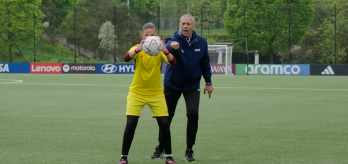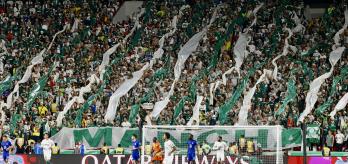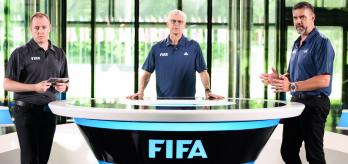In this session, FIFA Goalkeeper Coach Thierry Barnerat works with a group of young goalkeepers, concentrating on the correct leg and foot movements required, such as:
-
developing the required sensation needed in the inside foot for maximum push off;
-
transferring the body’s weight onto the inside foot by taking a step in the other direction first; and
-
handling the ball firmly using one hand behind for support and the other on top to keep it in place.
Exercise 1: Explosive one-knee low dive
This low-dive exercise focuses on the weight placed on the standing leg, which allows the goalkeeper to push out, stretching to reach the ball without giving way. The goalkeeper rests on one knee and must position themselves so they can focus on their footing and the explosiveness required when diving towards the post. One-handed saves are possible if the ball is too far.
Exercise 2: Eyes-closed power dive
This exercise helps to put a greater focus on the sensation a goalkeeper must feel when placing weight on the foot for maximum explosiveness. By closing their eyes and standing on one knee, the goalkeeper can pay more attention to their footing and the point of pressure, helping them to spring and dive to cover more of the goal.
Exercise 3: Inside-foot hop dive
In this drill, the goalkeeper starts in a standing position on their toes and must become conscious of the feeling in the foot and whole leg when pushing off to dive. By jumping to the opposite side first before returning and making a small jump, the weight can be transferred onto the inside foot to spring across the goal. The coach must time the pass well so the goalkeeper can arrive at the correct moment to save.
Exercise 4: One-hand secure push save
In Exercise 4, the goalkeeper must draw on the fundamentals of quality footwork to make a push-off so they can get across the goal more effectively. Firm ball handling can be achieved with one hand behind the ball and the other on top of it to hold it in place. If necessary, the goalkeeper must push the ball away from the goal with one hand.











